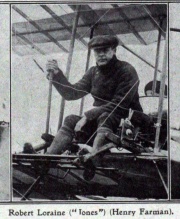Robert Bilcliffe Loraine
Robert Bilcliffe Loraine MC DSO (14 January 1876 – 23 December 1935) was a successful London and Broadway British stage actor, actor-manager and soldier who later enjoyed a side career as a pioneer aviator.
1876 Born in Liscard, Cheshire.
1936 Obituary [1]
It seems a very long time ago since Robert Loraine, who died in a nursing home after an operation just before Christmas, was astounding the embryonic flying world with his daring feats in a Henry Farman biplane with Gnome engine. Since the war one has thought of him almost exclusively as an eminent actor and theatrical manager, but in the pages of Flight of the year 1910 he appears constantly as one of the most notable of the flying pioneers.
He learned to fly in France in June, 1910, and his French certificate No. 126 was accepted by the Aero Club of the United Kingdom. He took his Henry Farman to the flying meetings at Bournemouth and Blackpool in that same year.
After the latter meeting was over he flew down to Southport, and then daringly set out across the sea to Cemlyn, near Llandudno. There he had a minor crash, but repaired his machine and reached Holyhead. After spending a night there he set out to fly the Irish Sea to Dublin. It was a tremendously reckless feat, considering how unreliable were the engines of those days, and to make matters worse he had no flotation gear of any sort. He had plenty of excitement during the crossing, though, to be fair to the Gnome, it was the petrol feed which nearly proved his undoing. Six times while he was over the open sea did the engine fail and bring him down almost to the level of the water, and each time it picked up just in time and allowed him to regain his height. When he was within a couple of hundred yards of Howth the final failure occurred, and the Farman and Loraine went into the sea. He swam to the lighthouse.
In the Army manoeuvres that autumn Loraine flew a Bristol fitted with a W/T transmitting set, and sent messages quite successfully from a distance of a quarter of a mile.
On the outbreak of war Loraine joined the R.F.C., and on October 26, 1915, he won the Military Cross for a daring attack on an Albatros. He drove it down from 9,000 feet to 600 feet, pounded the pilot and hit his camera and wireless transmitter. The Albatros fell in our lines. The citation in the London Gazette described this as a feat of "conspicuous gallantry and skill. In the Birthday Honours of 1917 he was made a Companion of the Distinguished Service Order.
At the battles of the Somme he commanded No. 40 Squadron, which he had himself raised. In due course he was promoted to Lieut.-Colonel and commanded a training station at home.
He married Winifred Strangman in 1921 and they had three daughters.








